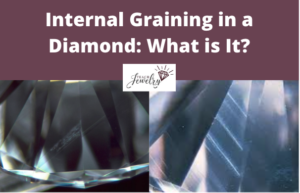
When you’re searching for the right diamond, there are many qualities to consider. In regard to its clarity, it’s worth noting how inclusions affects its brilliance, appearance, and durability.
One aspect of clarity that’s discussed less than those others is internal graining in a diamond.
Let’s explore everything to know about internal graining, including the two types, how it’s identified in grading reports, how it differs from surface graining, and if it can be removed.
What is Internal Graining?
Internal graining in a diamond is caused by abnormal crystal growth in its structure that result in streaks that appear below its surface.
When the crystal inside grows unevenly, such as stopping and starting or some growing faster than others, it creates waves and lines that travel through the diamond.
Here’s a close-up image of internal graining.
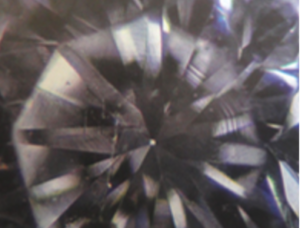
It’s a natural inclusion that develops as the diamond is formed below Earth and has the potential to impact its clarity grade.
Internal graining is most noticeable in large diamonds that have few other defects. If the diamond were filled with other inclusions such as feathers, clouds, or twinning wisps, these imperfections would be more prominent than the graining.
Additionally, many instances of internal graining are only visible at 10x magnification at certain angles and lighting.
If you held the diamond in one position, it may not be apparent, but if you rotated it at multiple angles, the graining may appear.
Internal graining is different than surface graining. Surface graining doesn’t occur inside the diamond but instead appears on its facets. It’s colored or transparent lines from defects in the crystal formation.
Similar to internal graining, you should be wary of a diamond that received its clarity grade because of surface graining. This indicates a more severe case as opposed to it simply not being shown on the report.
Types of Internal Graining
Reflective
Reflective graining results from the intense pressure placed on a diamond during its formation. It distorts the crystal lattice, where areas of the diamond slide relative to each other.
Here’s a high-resolution image of reflective graining within facets.
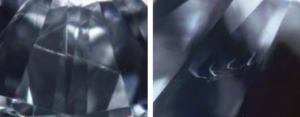
Although those lines appear long, that’s only because the image is magnified. To the naked eye, they’re incredibly small.
The distortion creates slip bands. When slip bands are placed under light and viewed at specific angles, it appears as reflective graining.
Reflective graining is most often found in smaller diamonds. Additionally, if it’s only present on one facet, it’s often invisible to the naked eye and even difficult to view with magnification.
Whitish
Whitish graining is commonly seen in diamonds more than four carats. Here’s how it appears with magnification.
So unless you have tens of thousands of dollars to spend on an engagement ring, there’s little need to worry about this flaw.
Here’s how it appears with magnification.
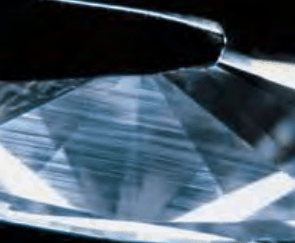
It can be broken down into three types: tatami, banded, and haziness.
Tatami and banded graining are the result of dislocations in the diamond lattice. Secondary effects including lowering the refractive index by distorting the path light travels through the diamond.
Both look like straight or wavy lines that disrupt the cleanliness of the diamond with their white and silky appearance.
Hazy whitish graining is a cloud-like inclusion made of tiny crystals.
These crystals are sometimes larger and considered pinpoints, but for instances where they’re microscopic, they create a haziness throughout the stone. It’s caused by the growth structure of the diamond and not specific inclusions lodged inside.
How is Internal Graining Identified on Grading Reports?
Organizations such as the GIA and AGS grade diamonds across their most important characteristics, so buyers can have confidence in their value. This includes internal graining.
When graining is transparent, it often doesn’t have an impact on the clarity grade. When it’s visible at 10x magnification, it can be incorporated into the overall quality.
Gemologists observing graining are often deciding whether the diamond should earn a flawless, internally flawless, or VVS (very, very slightly included) grade.
Flawless means the diamond has no visible inclusions at 10x magnification, while internally flawless has the same criteria but only for the inside.
If the reflective or whitish graining only appears on a small area of one facet, it may still earn a flawless or internally flawless grade.
Internal graining on a GIA report is identified in the “Additional Grading Information” section. For example, this one-carat diamond was given an SI1 clarity grade because of its clouds, pinpoints, crystals, and internal graining.
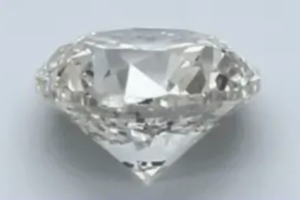
Here’s where that information is listed on the report.
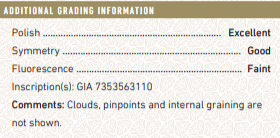
This indicates the internal graining has a minimal impact on the diamond’s appearance.
On the other hand, be cautious if the report states, “Clarity grade is based on internal graining that are not shown.”
In this case, the internal graining is significant enough to affect the diamond’s overall clarity grade. If the graining wasn’t present, it would’ve received a higher grade.
How Does It Impact a Diamond’s Price?
Internal graining impacts the price of a diamond because it has the potential to lower its clarity grade. All else being equal, diamonds designated internally flawless sell for a higher price than VVS1 diamonds.
For example, let’s compare two diamonds with the following characteristics:
- Ideal cut
- G color
- 1.01 carats
The only difference is the diamond on the left is graded VVS1 because of graining, and diamond on the right is internally flawless.
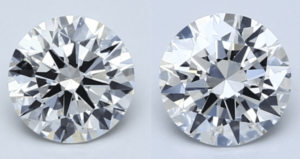
The internally flawless diamond is priced at $7,049, and the VVS1 diamond sells for $6,708. This five percent difference is a result of the lower clarity grade.
This concept would continue to play out as the internally flawless diamond is compared to ones with even lower clarity grades, which can be caused by internal graining.
A VS1 diamond with all the same qualities except for the clarity sells for below $6,000. That’s a price difference of more than $1,000.
SI2 diamonds, which often feature heavy amounts of inclusions and graining, sell for below $4,000.
Can it be Removed?
Diamond cutters cannot remove internal graining on a diamond without reducing its carat weight. Because the imperfections are inside the stone, it would require cutting away too much of the diamond to be worth the cost.
Carat weight has a significant impact on the selling price of a diamond, so any treatment that removes carat weight is generally avoided unless the lack of flaws would raise the price relative to what the reduction in weight lowered it.
Even additional polishing won’t remove internal graining. If you’re concerned about its impact on the appearance or brilliance of your diamond, there are plenty available without graining.
To stay within your price range, you may have to choose a lower grade in areas such as color, cut, or carat.
How Does Internal Graining Compare to Other Inclusions?
Internal graining isn’t the only type of inclusions present in a diamond. They can develop multiple imperfections, either during its formation or from man-made errors.
Compared to other inclusions, internal graining is more difficult to identify. It often requires magnification and rotating the diamond to view it at multiple angles.
From there, it must be decided whether the graining is internal or on the surface and how far it extends. Other inclusions such as feathers, dark crystals, or the below twinning wisps can sometimes be seen with the naked eye.
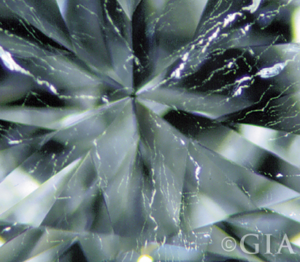
Another distinction between internal graining and other inclusions is graining doesn’t result in a discontinuity of the diamond’s structure.
Fractures, cavities, and cleavage leave an open space in the diamond, which leaves it vulnerable to chipping.
Overall, internal graining is less of a concern for a diamond’s appearance, light performance, and durability compared to most other inclusions.
Should You Ever Buy a Diamond with Internal Graining?

Internal graining shouldn’t be a dealbreaker. It’s often a minor inclusion that even professional graders have difficulty identifying and deciding how it should affect clarity.
But pause if you find a diamond with a low clarity grade the report says is because of internal graining. It likely will have a noticeable effect on the diamond.
Otherwise, it would be noted on the report but not indicate how it lowered the grade.
By understanding internal graining and how it compares to surface graining and other inclusions, you can learn how you should take this feature into account among the many qualities that make up a diamond.

Jacob Clarke
Jacob Clarke is the founder of TeachJewelry.com.
He earned an Applied Jewelry Professional Diploma from the Gemological Institute of America (GIA) and now brings you essential information about diamonds, settings, and more.
Jacob has consulted with leading jewelry brands, and his work has been cited in Clean Origin, Diamond Nexus and industry publications.
He's also a member of the International Gem Society.
He enjoys discussing jewelry with readers, so contact him with any questions at jacob.clarke@teachjewelry.com.













